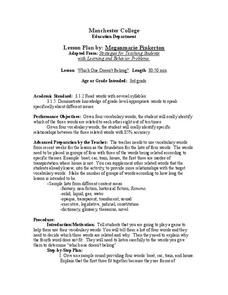Curated OER
Find the Rhyme
Find the rhyming word. All of these rhyming, single-syllable words have the short i sound, but learners have to determine which ones they are. There are four starting objects each heading a row of three objects. They examine the three,...
University of Texas
Essential Reading Strategies for the Struggling Reader
Beneficial for beginning readers, struggling readers, and those in need of review, a set of language arts activities is a great addition to any foundational reading unit. Focusing on phonological awareness, fluency, instructional...
Curated OER
Draw it Yourself
What rhymes with fox? Get learners engaged with rhyming words through this drawing worksheet featuring four single-syllable words for beginning readers. For each, they draw something that rhymes with the word. Challenge learners who need...
Curated OER
Gingerbread Phonological Awareness Pictures: Syllables
In this syllables worksheet, learners say the name of the horse, fox, gingerbread man, and stove. Students listen to the phonological sounds and syllables in the words.
Curated OER
Identifying and Generating Rhyming Words, Body
Can you tell which words rhyme? Choose a body part as a starting word (i.e. head) and begin saying words to see if learners can identify those that rhyme. Does red rhyme with head? Continue giving examples, some rhyming and others not....
Curated OER
Odd Ones Out
Some of these words don't rhyme; scholars determine which ones as they examine four sets of images with the vowel sound /e/. For each set, they circle the words that don't rhyme with the first image. Be sure kids know what these images...
Curated OER
Find the Rhyme
Which one rhymes? There are four starting objects here, each heading a row of three objects. Learners identify the objects and their vowel sounds to determine which one rhymes with the first object. All these rhyming words involve the...
Curated OER
Find the Rhyme
Which of these objects rhymes? There are four starter pictures here, each heading rows of three objects. Learners determine and circle the row object that rhymes with the first one. Then, they connect two of the CVC words with printing...
Curated OER
Odd One Out
Which word doesn't rhyme? As they practice vowel-sound recognition, scholars examine rows of familiar objects to determine which object doesn't rhyme. There are four rows here, each with a beginning image and three subsequent images....
Curated OER
Match the Rhymes
Explore CVC words with the vowel sound a to give pre-readers a grasp of rhyme. They draw lines from a van to surrounding pictures that rhyme (man, pan, fan, can). Then, leaners get printing practice by tracing the words van and fan....
Curated OER
You Too Can Haiku
Students conduct Internet research and explain the history of Haiku. After listening and reading various examples of Haiku, students use their own vocabulary and practice their math skills to determine the correct number of syllables...
Curated OER
Stress in English
In this stress in English worksheet, students mark the stressed syllables in a set of words after reading a brief paragraph of information about how to proceed.
Curated OER
Can You Hear the Sound?
Learners recognize the short vowel e in spoken language. Through matching activities, they discriminate the short vowel /e/ from other short vowel phonemes. Students associate the phoneme with its letter representation and identify the...
Curated OER
Which One Doesn't Belong?
Third graders identify words that are related with 80% accuracy. Given a list of four vocabulary words, 3rd graders identify specific relationships between three of the four words. They also identify which of the four words are not...















